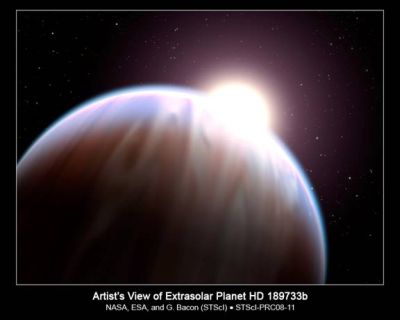23 March 2008

NASA's Hubble Space Telescope (HST) has made the first detection ever of an organic molecule in the atmosphere of an extrasolar planet (a planet orbiting another star). This startling discovery is an important step towards identifying signs of life on extrasolar planets, also known as exoplanets.
The molecule detected by Hubble is methane, which under certain circumstances can play a crucial role in prebiotic chemistry, the chemical reactions believed to be necessary for the formation life.
This discovery demonstrates that Hubble and upcoming space missions, such as NASA's James Webb Space Telescope, can detect organic molecules on exoplanets by studying their chemical makeup through spectroscopy.
"This is a crucial stepping stone to eventually characterizing prebiotic molecules on planets where life could exist," said Mark Swain of NASA's Jet Propulsion Laboratory (JPL), who led the research team that made the discovery. Swain is lead author of an article that reported the discovery.
The discovery was made through extensive observations made in May 2007 with HST's Near Infrared Camera and Multi-Object Spectrometer (NICMOS). It is also a confirmation of the discovery of water molecules in the planet's atmosphere, made earlier in 2007 by NASA's Spitzer Space Telescope (SST). "With this observation there is no question whether there is water or not — water is present," said Swain.
The exoplanet, known as HD 189733b, is a Jupiter-sized planet, located 63 light-years away in the constellation Vulpecula (the Fox). It is too massive and too hot to host life. HD 189733b, dubbed a "hot Jupiter," is so close to its parent star that it takes just over two days to complete an orbit. Due to its proximity to its parent star, HD 189733b's atmosphere swelters at nearly 930 degrees Celsius, about the same temperature as the melting point of silver.
The observations were made as the planet HD 189733b passed in front of its parent star in an event known as transit. As the light from the star shone briefly through the exoplanet’s atmosphere, the gases in the atmosphere imprinted their characteristic signatures on the starlight from the star HD 189733.
The astronomers were surprised to find that the planet has more methane than predicted by current models for hot Jupiters-like exoplanets. "This indicates we don't really understand exoplanet atmospheres yet," said Swain.
"These measurements are an important step to our ultimate goal of determining the conditions, such as temperature, pressure, winds, clouds, etc., and the chemistry on planets where life could exist. Infrared spectroscopy is really the key to these studies because it is best matched to detecting molecules," said Swain.
Further Reading
HST’s News Release
http://hubblesite.org/newscenter/archive/releases/2008/11/full/
Hubble Site
http://hubblesite.org/
Spitzer Site
http://www.spitzer.caltech.edu/spitzer/index.shtml
Aymen Mohamed Ibrahem
Senior Astronomy Specialist